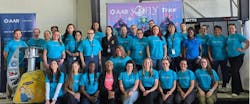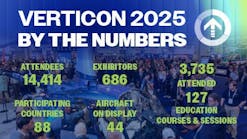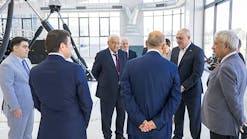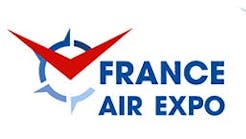Having entered the aviation maintenance profession in the 1970s my upbringing was mostly in the hands of members of the “Greatest Generation” whose capabilities, knowledge, and wisdom enabled, empowered and motivated newcomers in the field to carry on their mission. As I recall back then regulations were written in a way that a reasonable person could interpret the intent without a coven of lawyers. The “Aircraft Mechanic’s Creed” was written in 1941 by Jerome Lederer and was initially published by the Flight Safety Foundation in May 1953. In spite of technological evolution it is a timeless creation. I was exposed to this document early in my career and have kept it near ever since (pdf version available at FAASafety.gov).
One of the many lessons learned not only in the aviation profession but in life in general is that change is certain and nothing stays the same for long. Change is not necessarily a bad thing as long as the implementation is for understandable reasons. Many employed in the aviation technical field possess an analytical thought process which lends itself to the ability to solve complex problems quickly by adapting a methodical approach to exploring all the associated elements. Unfortunately, if there is no perceived problem, changing a process or procedure can create disruptions both in productivity as well as work force moral.
Solid Career Path
Globally aviation is on an up-swing with industry forecasts from both Airbus and Boeing predicting the worldwide fleet of aircraft will close to double by the year 2030 and the need for qualified technicians will increase exponentially. Many of us have experienced cycles in our business over the years where effects associated with merger, acquisition, outsourcing, downsizing, and rapid uncontrolled growth have all taken their toll or in some cases provided significant reward to those capable of adapting or resilient enough to withstand the change. Many industry outsiders often perceive that our profession may not provide a stable and secure career path.
Having had the opportunity to deliver “Career Day” presentations I was alarmed to learn many high school guidance counselors consider aviation maintenance a declining career field and seldom recommend it to their students. I am pleased to say that after the last such presentation all the students in attendance were allowed to get in line in front of the four presenters including; accountant, doctor, health care professional, and myself to ask one or two questions, my line was over two times longer than anyone else’s. This may be attributed to the fact I included a picture of Taylor Swift’s aircraft. The guidance counselors also cornered me once the program concluded and were amazed at how our occupation has evolved and the new opportunities that have been created.
Just what has prompted the renaissance in our profession? It has been known for many years that regulations globally dictating the “Need to Know” of aviation technicians were at best antiquated. Yes, in the U.S. Federal Aviation Regulations (FAR) Part 43 and Part 65 had seen some revisions and the FAA realizes the need for additional amendments. The European Aviation Safety Agency (EASA) recognized and adopted Part 66 in an attempt to cover those tasked with ensuring airworthiness were up to the task. In part this requires demonstrating knowledge on type specific aircraft with separate certifications for mechanical and electrical/electronic areas.
Core Competencies
An initiative started back in the late 1980s by a business aviation technician named Brad Townsend called “Project Bootstrap” eventually evolved into formation of an industry-driven global standard under the ASTM (astm.org) committee F46 banner addressing qualifications of aerospace personnel. This dedicated group includes representatives of all aspects of aviation-related businesses, professional organizations, educational institutions, regulatory agencies, and dedicated individuals. Accomplishments so far include formulation of standards addressing core competencies and aircraft electronics technicians (AET). There are other opportunities as well dealing with advanced composites, design, and manufacturing concepts and support roles. Everyone needs to get involved!
There is no cost to join and each person has a unique perspective on what our industry needs. There will always be a need for those with a keen eye and ability to pay attention to detail along with the craftsmen capable of implementing complex repairs under other than ideal circumstances.
With forecasts indicating the rapid deployment of new technology aircraft and the fleet doubling within many of our lifetimes we cannot forget how to support older equipment as they too will continue to occupy the skies with the same emphasis on airworthy. Millennials borne in the information age have an acquired knowledge of use of electronic devices and built-in diagnostic capabilities but are often unprepared to contend with problems associated with analog devices. It appears the ability to troubleshoot using multi-meters and other yesteryear diagnostic tools are becoming “tribal knowledge” and the tribe is rapidly dwindling.
The Importance of Soft Skills
Included in core competency are numerous soft skills. In the past participation in our industry was focused on technical capabilities and/or skills. The ability to communicate, negotiate, and lead others was never truly nurtured and only in recent years has the realization materialized and educational programs have been introduced to meet the need. Another misconception is that a good manager automatically makes a good leader and it was often assumed that the best technicians would make the best managers. In my career I can honestly say I have been associated with several of the very best leaders in the industry plus a few of the very worst and have thankfully learned from all of them including consideration of ego and degree of maturity.
A common opinion among the aviation community is military protocol recognized pilots as officers and leaders while mechanics are the enlisted personnel with limited advancement possibilities. This concept has impacted many aspects of the aviation industry throughout the years. Yes, many of us have persevered to relate to pilots. After all, if it weren’t for them, most of us would be unemployed! The best aviation organizations most often operate on a team concept where all members interrelate to achieve a common goal. Unfortunately individual rank within an organization does not prove the ability to effectively lead nor does an assortment of college degrees, age, or even family heritage.
Many of the best leaders I have been privileged to work with come from humble beginnings and most share the belief that those that they lead are in fact the most important assets. A positive outlook, thorough understanding of the organization's goals and objectives coupled with a sincere concern for others are essential parts of being effective in a leadership role. Aviation interpersonal skill development programs are worthwhile in creating the basics and honing dexterity. Knowledge is only part of the career enhancement equation. There are many under-employed yet knowledgeable people in our industry. Wisdom is the key to knowledge utilization and is a quality built around acquired pertinent understanding, experience, and good judgment. Of course good judgment is based on experience and a lot of that comes from previous bad judgment!
Today's Technician
One of the criteria for being considered “Old School” is the adherence to traditional policies and practices. Yes, we are “mechanics” even though by today’s criteria “technician” may be better suited to our role. A “mechanic” is defined as “one who fixes things” and that is exactly what we do, by sharing knowledge, using sophisticated diagnostic equipment, analytic thought processes, or just common sense coupled with trust in our colleagues. As the “Keepers of Airworthy” we all share a grave responsibility to exercise good judgment and to strive toward the advancement of aviation and to the dignity of our profession. This is one thing that I hope never changes.





